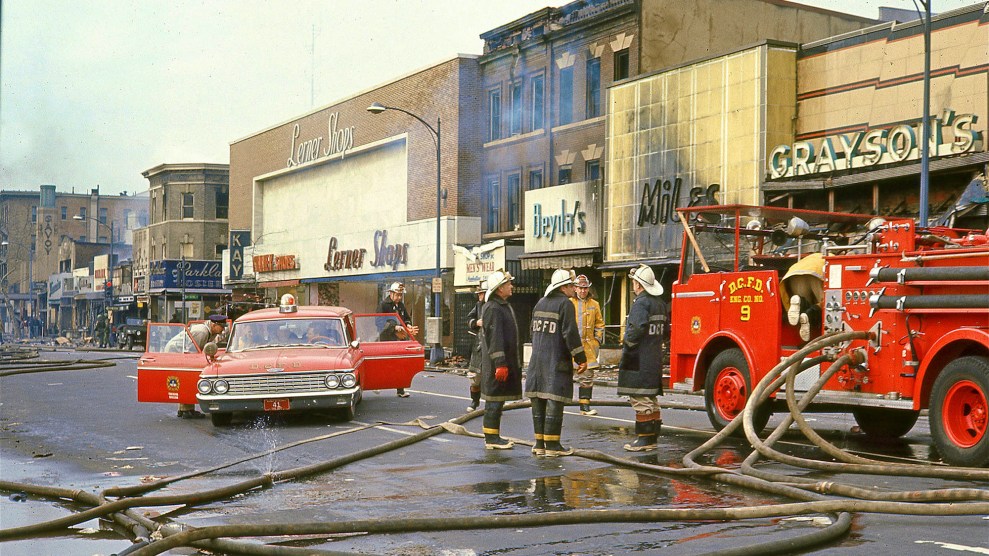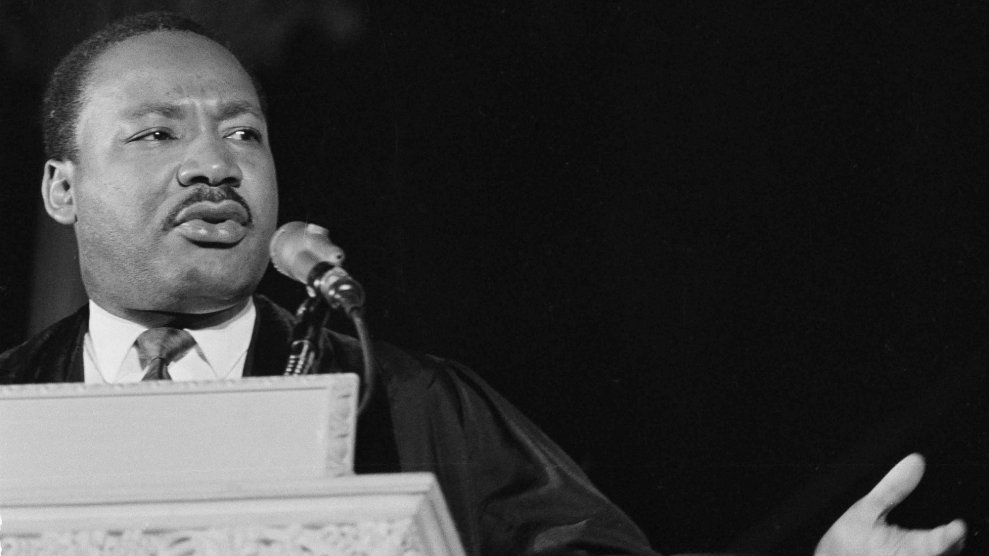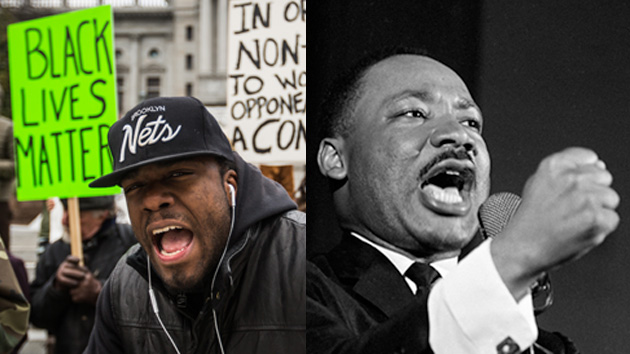
Firefighters gather on 14th Street near Irving Street in the Columbia Heights neighborhood of Washington, DC, on April 6, 1968, following rioting after the assassination of Martin Luther King Jr.Darell C. Crain/AP
Even as demonstrations against anti-Black violence have become tragically routine, the events of the past few days stand out. They are the largest nationwide protest against the killing of a Black man since the unrest that followed the assassination of Martin Luther King, Jr., on April 4, 1968. Then, just as now, an outpouring of grief and anger sent demonstrators into the streets in cities across the country, and mayors, police departments, and federal officials scrambled to prevent the upheaval from claiming lives and destroying property. Some cities more or less succeeded, while in others—including Washington, DC, Baltimore, and Chicago—the pent-up rage of African American residents overwhelmed the government response and left smoldering neighborhoods that would take decades to recover.
What approaches helped mitigate the violence and damage? Which ones backfired? I spoke with Clay Risen, author of the 2009 book A Nation on Fire: America in the Wake of the King Assassination and now the deputy op-ed editor at the New York Times, to find out about the lessons learned from the responses to the protests of a half-century ago.
Of all the cities that saw major protests in 1967 and ’68, is there one that did the best job of avoiding widespread violence and destruction?
The one that sticks out is New York. It explains a certain amount of what went right and what went wrong, in terms of the way the mayor and police responded, in a sense that provides lessons for today.
People talk a lot about what [Mayor John] Lindsay did on the night of April 4: how he was pulled out of a play and immediately went to Gracie Mansion and then to 125th Street [in Harlem] and walked around and put himself bodily into the crowd. Even when some of his aides were saying that not only should he not be there, but the cops should be allowed to be more aggressive and should crack down on the crowds, he resisted.
There was some window smashing here and there, but it wasn’t a violent protest, and Lindsay understood this. It was people feeling incredible grief over the assassination of Martin Luther King. Lindsay had his finger on the pulse on the crowd that night and understood, people just want to express themselves. And they want to hear from leadership. And they want to hear from him, to say, I’m with you.
The important thing to note about what Lindsay did was, shortly after taking office, he worked very hard to put in place a network of community leaders that were not always the most obvious. Not necessarily the preachers, not necessarily business leaders. Sometimes they were gang leaders, or people the community listened to. He cultivated them and made it clear that the city needed them to play a role in keeping the city safe.
So after he walked around among the crowd, he went and met with some of these people and said: We’re relying on you. Now it’s up to you. Those people went out and made sure that the community stayed reasonably nonviolent. And it worked. For as much crap as Lindsay gets, and a lot of it deserved, that was an amazing performance. And it wasn’t just a performance; it was the playing out of a plan that he’d had in place for a while.
That reminds me of other cities where the leadership couldn’t really control the crowd so it called in influential African Americans, like in DC, where Walter Washington (the federally appointed mayor-commissioner) called in James Brown to issue a plea to people to calm down.
Well that started in Boston. That night [of the King assassination], there was a James Brown concert in Boston. And Mayor Kevin White made it clear to James Brown that hey, we’re not gonna cancel your concert. There was concern that all these Black people were gonna hear James Brown and then riot. But the mayor saw things differently and said, first of all that’s racist, and also, this could be a very effective way of fighting that. You get a bunch of people together, and you have an authority figure like James Brown, someone people will listen to, and in the course of performing, he can also make it clear that people should respond in a certain way. Boston’s another example of a city where you didn’t have that kind of violence.
DC’s a weird counterexample, because on the one hand, you had, that night of April 4, [Student Nonviolent Coordinating Committee Chair] Stokely Carmichael among others out there in the community saying, look, I know how you feel, but we don’t need violence tonight. He really didn’t want to see violence. He understood what that would mean in terms of a police backlash or political backlash. But he wasn’t enough.
Part of that was the weirdness of Washington at the time. There wasn’t an effective leadership. The federal government was the leadership. And it was completely unresponsive to the needs of the community. There just wasn’t a power structure in place to respond to that.
It seems that the kind of restraint Lindsay had was key to avoiding widespread death and violence. But then, in various cities, you had store owners who were upset that the government didn’t do more to crack down on looting and arson that destroyed their businesses. Was there a degree of physical damage that was just unavoidable, and the best thing you could do was just try to avoid loss of life? Were those two things actually pitted against each other?
Oh, for sure. In the ’60s, the violence was not directed at symbols of authority. The police were not targeted and government buildings were not targeted, unlike today. The target really was store owners. They were commodity riots in that sense. On the one hand, there were a certain number of people just taking advantage of the moment, saying, I’ve been living in pretty terrible conditions and here’s my opportunity to get something. But then others really targeted specific store owners. DC is a great example of this. There was a history of storeowners, most of them white, who were understood to be taking advantage of Blacks, selling them terrible stale bread and charging a premium, giving them layaway programs with enormous amounts of interest. So you saw targeting of individual stores. Very rarely did you see people go out of their way to attack cops or fire stations or courthouses.
That’s the dynamic in the ’60s. It’s different today. I don’t get the sense that people are out there to burn down their cities, in the way that in the ’60s there really was a “burn it down” attitude in certain places.
Well, we have seen a lot of fire these past few days, especially here in DC. And in 1968, arson did the most damage in DC and caused the majority of the deaths. Did any city have an approach that succeeded in stamping out arson before it got out of hand?
That’s a good question. Nothing jumps to mind. There was arson in New York—so maybe New York would still be the best example of that. Again, this speaks to the capacity of Lindsay and the NYPD and the community structure that Lindsay had in place to get in where there was arson pretty early.
One thing I would say is—compare it to what happened in Detroit in 1967, where a lot of the death was caused by cops and really underprepared National Guardsmen. The famous Algiers Hotel incident happened during the violence. You had a bunch of people who were untrained in crowd control, untrained in the kind of weaponry they were given, and just started firing into a hotel because they thought there was a sniper. There was no sniper, but they killed lots of people.
This is kind of a weird thing to say because the legacy is problematic, but it’s to the credit of law enforcement and the military that between Detroit and Newark in 1967 and April of 1968, they created this whole infrastructure of training and escalation procedures that meant that very quickly the police were supplemented by National Guardsmen who had training, and where that wasn’t enough, active army came in. That, and curfews and all sorts of other ancillary mechanisms, really brought the violence to an end in Chicago, and Baltimore, and DC.
You tweeted yesterday that the ’68 riots led to the militarization of police. Is that because the tools they had in ’68 were seen as inadequate?
It’s a couple of things. First, the military had a huge amount of surplus gear they needed to offload. There was a rapid increase in the size of the defense industry, and those companies, especially by ’68, were starting to realize the war’s not gonna go on forever, and a lot of the things they had developed as tools for the war are gonna need new markets. And what a great market! All of these scared city and state law enforcement agencies. Part of the war-on-crime legislation of the late ’60s explicitly said we’re gonna fund or support the purchase of surplus military gear for local law enforcement.
The other thing is the development of the SWAT team. The whole concept of the SWAT team emerged out of Watts [the Los Angeles riots in 1965]. [The LA police chief] saw the need for rapid military-style responses to mass violence, and he had the idea of SWAT as a kind of paramilitary force within the police department to go after radicals, the people behind the protests. Throughout the late ’60s, he went around the country talking to police forces about how to set it up.
All of this kind of comes together, where you have a supply, you have a demand, and you have a lot of scared biz leaders and government officials. It’s just sort of a perfect storm.
There’s some disagreement over whether curfews work. On Sunday, things seemed to escalate after the curfews went into effect. In 1968, were they seen as effective?
Not really. It’s just an additional tool. If you’re out after curfew, you could be arrested. I don’t think they really kept people home. It was more of a law enforcement tool. It wasn’t nearly as important as many of the other measures. It just gave police the capability to make arrests where maybe otherwise they couldn’t have.
I want to ask you about tear gas, which is obviously being deployed now. In some cities in 1968, tear gas was seen as the police’s most effective tool. Did it work to prevent violence?
It was effective in terms of controlling the course of a crowd. If you wanted to block off a street or push a crowd in one direction, that’s what tear gas was good for.
Was it helpful to move crowds in certain directions, or just redirect the damage?
It probably just redirected people. Unlike today in a lot of places, there was no direction. It’s not like there was a protest march where things got ugly. From the beginning, it was just people out in the street expressing themselves in whatever way they felt appropriate, and that often turned violent. It was much more of a mass event.
Certainly in DC and Chicago and Baltimore, the thing that made the difference is partly just the playing out of emotions. After a while, people were spent. But also the resolute response from the police and National Guard and US Army, just coming in and—particularly for the Army—very calm and resolute: We are here to make sure nothing happens. In DC, once the military came in and soldiers and jeeps were on every corner, people are gonna stop being violent. There’s really no energy after that.
Let me ask you in closing: Trump is going off and demanding that governors get tough and stop being such wimps. If you could offer one counter-plea, telling governors and police chiefs, hey, I’ve studied ’68, here’s what not to do—what would you tell them?
It would be: The protesters are not the bad guys. They’re not the enemies. And the political leaders in ‘68 who got that as their political leadership agenda, that the people in the streets are not the bad guys, that if you give them room to express themselves and make it clear that you’re working with them—look, you’re not going to avoid violence. It’s going to happen. But you’re going to avoid things spinning out of control. And you’re going to leave the door open to solutions after the fact.
If you start from the premise that we’re all working together, we’re experiencing grief together, and at the end of this we’re going to find a solution together, that’s much better than saying, the protesters are the bad guys, the police are the good guys, we’re gonna go in and control them. At the end of the day, all you have is bad blood. Instead of a place where you can have conversations afterward, you end up with a place like Chicago, where all you do is entrench racial antagonism and police-community antagonism.
Lindsay is a good example of how to do that. He is also something of a cautionary tale, in that that alone is not enough. New York did not become this racial utopia after 1968. In fact, quite the opposite. And he made a lot of mistakes. The Lindsay administration is not the gold standard by any means of good mayoral leadership. So that is not the key to everything. But I think that has to be the starting point.

















